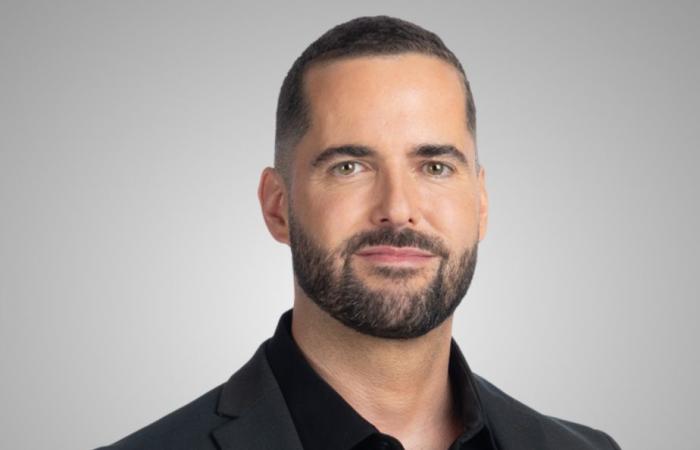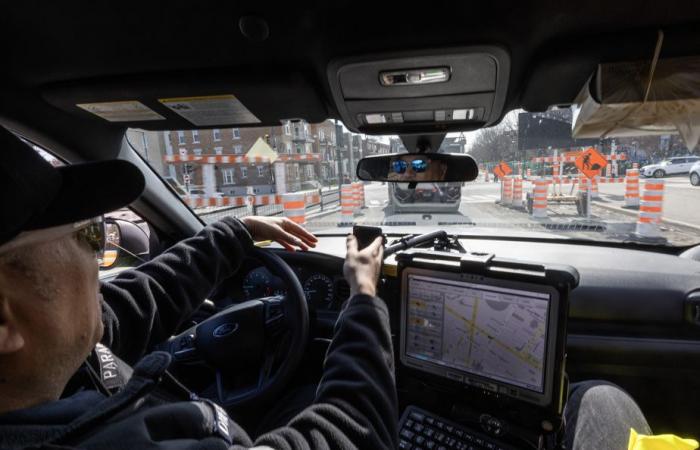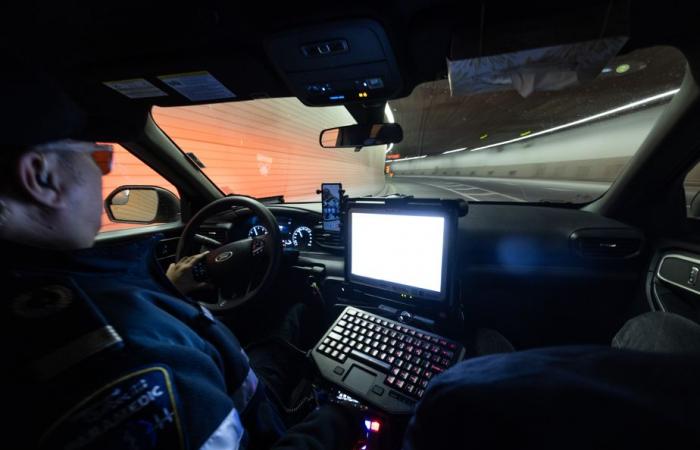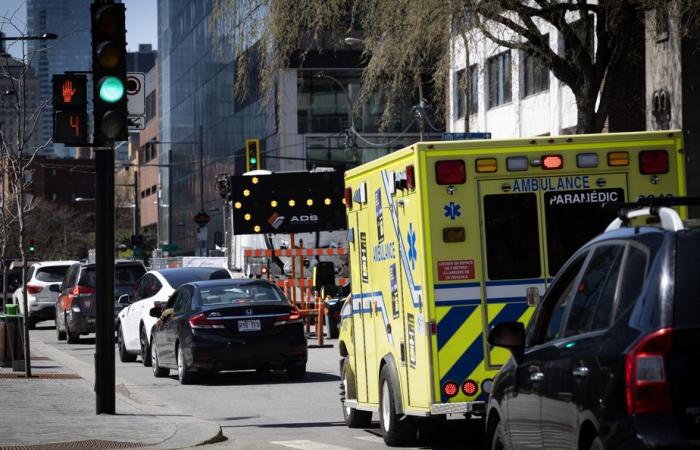Difficult to travel in Montreal? Talk to the paramedics. The multiplication of sites makes their work more hazardous than ever. If we add to these obstacles the lack of civility of motorists, who ignore mermaids and beacons, the disaster watches them with each intervention. Our columnist accompanied a supervisor in the field.
Posted at 5:00 a.m.
The call enters 9:41 a.m. an accidental firearm discharge in the Old Port of Montreal. At least one injured.
This morning I accompany Jean-Mari Dufresne, emergency supervisor, in his patrol vehicle. A big Ford Explorer filled with all the imaginable medical equipment.
The initial idea: to allow me to observe, for a few hours, the difficulties that the first respondents have to circulate in the streets of the metropolis. What I see as a bonus: a lack of civility frightening with many motorists.
It’s scary, I warn you.
Shoot in Old Port, therefore. We are on Pie-IX, near Notre-Dame East, when Jean-Mari receives the info. In the heart of a construction area.
There are orange cones on one side, fences on the other. And in front of us: a line of cars at a standstill. Only one way to “circulate” (notice here the use of quotes).
The supervisor activates the siren and the beacons. Klaxonne in a thunderous way. Nothing moves an inch. Three good minutes pass before a path finally opens, pain and misery.
An eternity in emergency.

Photo Patrick Sanfaçon, La Presse
The supervisor for emergencies-health Jean-Mari Dufresne, in traffic at a site on the boulevard Pie-IX
It has always been a bit problematic, but for five years there has been an increase in work, which generates much more detours. It increases response times.
Jean-Mari Dufresne, emergency supervisor-health
We finally reach Notre-Dame, in front of the Lantic sugar plant. Turn to the west at full speed. And almost immediately: Bang, another plug. The vehicles are well corded, on two wide tracks.
“We are going to do Moses and the separation of waters,” says Jean-Marie, a steering wheel.
An opening is finally emerging. Our Ford Explorer slips there, but it gets stuck again a few hundred meters further.
Jean-Mari branches off towards the two lanes in opposite direction. It rushes at a speed of hell in the opposite direction. Smile tense of your columnist. new traffic jam, at the Jacques-Cartier bridge. The driver crosses the median in a metallic crash.
The journey continues at a tomb open in the Tunnel Ville-Marie, on Bonaventure, until our destination, on the edge of the river. The injured person is already taken care of by paramedics and their condition is under control.
A first call in fact …
It is thanks to a reader of The pressambulancers for 23 years, that I find myself in this adventure. The man wrote to me to denounce the omnipresent work, the multiplication of unique senses, giant nests, in short, the complexity and decrepitude of Montreal streets, which “contribute strongly to the intervention time of your emergency services”.
This leading to this, I found myself spending a lidge with Jean-Mari Dufresne. He has been a paramedic since 1995, and supervisor for five years. “The best job in the world,” he said.
In his role, he has an overview of real -time emergencies. The number of calls that enter, priority cases, the number of paramedics available …
“The priority goes from zero to eight, zero being the most serious,” he explains to me. At the moment, there are 53 active urgent calls, 206 current calls, 76 ambulances and 13 calls awaiting assignment. »»
Emergencies-Santé covers the entire territory of Montreal and Laval. It’s huge: 744 km2the equivalent of 13 times the island of Manhattan.

Photo Patrick Sanfaçon, La Presse
The emergency supervisor Jean-Mari Dufresne
Our morning is after all quite calm, but the situation can quickly become tight. “It becomes critical when you exceed 70 calls on time. »»
The ambulance company is reviewing its entire navigation system, which is starting to date. Jean-Mari Dufresne demonstrates me on his big screen. The fastest journeys to go to the location of an emergency are marked with a pink line.
But here it is: there are so many sites everywhere that nothing is up to date. Paramedics must also trust the navigation application Wazereputed to be very precise, and to their own knowledge of the field.
The deadlines lie down, in any case. This does not appear in official emergency-health statistics, which also include data from other first respondents (police, firefighters), but all the paramedics I spoke to me.
And in the most critical cases, the extension of the response time can differentiate between the life or death of a patient.
-
Photo Patrick Sanfaçon, La Presse
The emergency supervisor Jean-Mari Dufresne, in the Tunnel Ville-Marie
In the case of a cardiorepiratory arrest, for every minute when there are no RCR maneuvers, the chances of survival drop by 10 %. After 10 minutes, you’re not bad.
Jean-Mari Dufresne, emergency supervisor-health
Among the most complicated sectors, he called me the Plateau Mont-Royal, Côte-des-Neiges or Saint-Léonard. And not surprisingly: the city center.
The situation is disastrous around the boyfriend, which receives dozens of ambulances every day. There are currently work all around to build a cycle path that irritates the establishment.
During our passage next to the megahôpital, rue Saint-Denis, our vehicle remains stuck in a cap for three or four minutes. Emergencies-health had to review his ways of doing things around the problem.

Photo Patrick Sanfaçon, La Presse
During the passage of our columnist next to the megahôpital, rue Saint-Denis, the vehicle remained stuck in a cap for three or four minutes.
“What we have given our troops as a directive is not to come from the north,” explains Jean-Mari. They are told to arrive from the east or from the south, because we know that there will be deadlines. »»
And despite all the work, the state of the streets does not improve. On the contrary. The level of degradation of roads, filled with bumps, crevices and holes, represents a real danger for paramedics, and especially their patients.
It brings and it brews in vehicles, it’s acquired. There are protective shells for the injured. But they are not magical. “There are cases where it will aggravate injuries, in cases of trauma for example,” emphasizes the ambulancer. There is also a danger of extubation … “
Work everywhere in Montreal and streets in poor condition: nothing too new under the sun. What marked me the most of this short experience, and frankly shocked, is the lack of absolute courtesy of many motorists and truckers.
On several occasions, despite his mermaid and his beacons, Jean-Mari had to find a way to get around them, crossing a median or by taking an opposite path. The reason is simple: drivers do not give in!
There is a decrease in civility, absolutely, and an increase in ignorance. People do not know their road safety code, they do not pay attention to what is happening around them, with all stimuli, their phone, their GPS.
Jean-Mari Dufresne, emergency supervisor-health
Another paramedic told me about the frequent threats he suffered during his interventions. Like this motorist wedged behind his vehicle, in a street in Plateau, while he was trying to resuscitate a patient in respiratory arrest. He threatened to have him “offset”.
There are also all these messages of insults left on his windshield … because what is a human life worth a few minutes of waiting, sitting comfortably in his tank ?
It is a reflection of our society, I’m afraid. That of a filthy individualism.
In figures
363 868
Number of medical emergency calls received by emergency-health during the financial year 2023-2024 in Montreal and Laval
284 465
Number of medical interventions carried out that same year by paramedics
744 km2
Territory served, the equivalent of 13 times Manhattan.
777
Average number of paramedical interventions every day in Montreal and Laval.
999
Number of paramedics for the Montreal and Laval territory. It is a drop of 24 enrollment compared to the previous year.
6 minutes 42 seconds
Response time for priority calls 0, the most urgent, which represents the average of the period between the response to the call and the arrival at the scene of the first prehospital resource (paramedical or first respondents).













